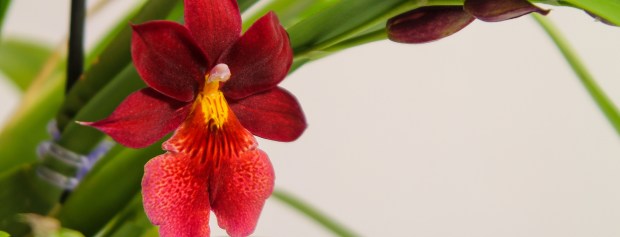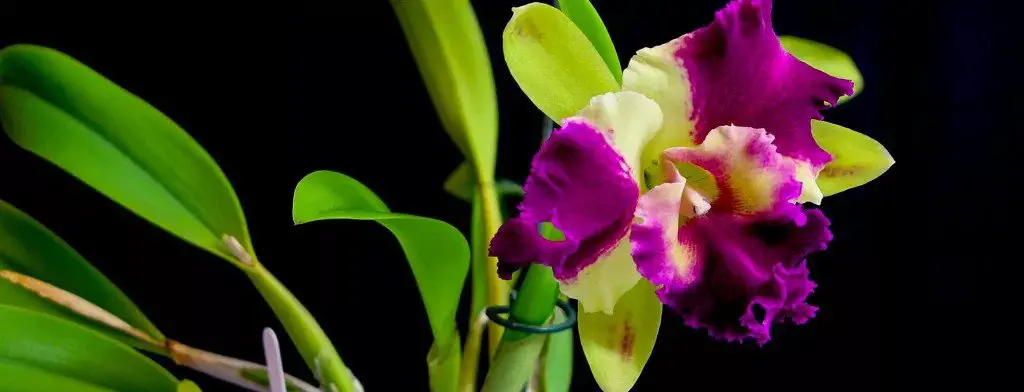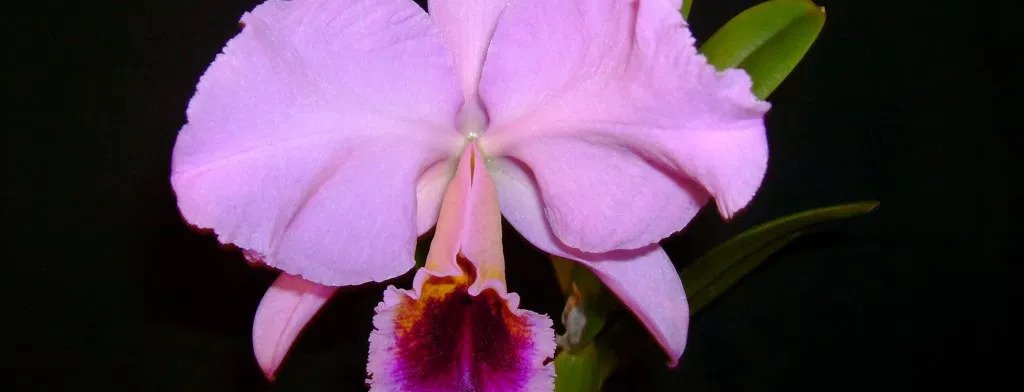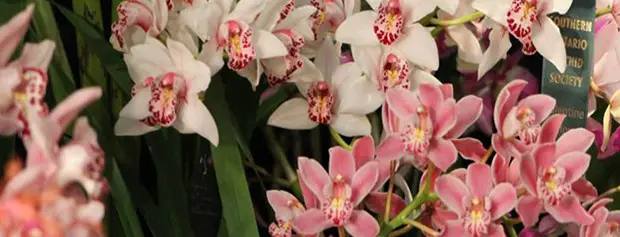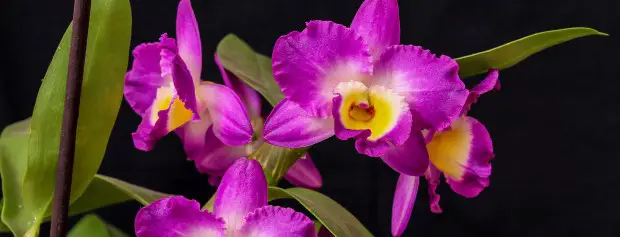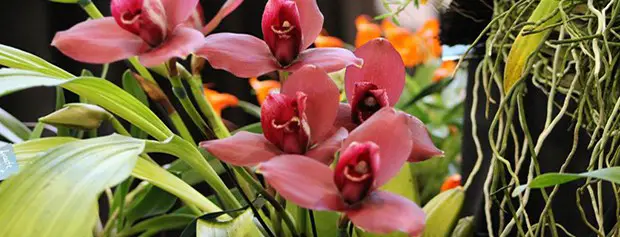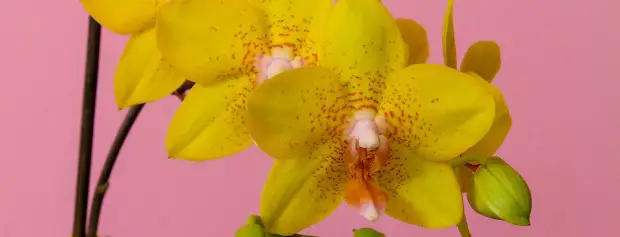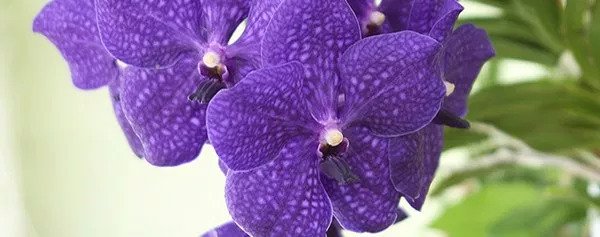1. Burrageara (Oncidopsis) Nelly Isler Care Sheet
Light: Low to bright
The Nelly Isler can grow well in lower light levels as well as bright shade. It will, however, not appreciate the hot direct sun. A sure way to tell that your Burrageara is receiving too much sun is the yellowish color of the leaves.
Phalaenopsis light will suit this orchid, so that an eastern exposure will do. Southern or western exposures need to be partially shaded to avoid leaf burns, while northern exposures might not suffice.
Temperature: 55º F (13º C) to 80º F (26º C)
The Burrageara Nelly Isler likes cool to intermediate temperatures, as its Miltoniopsis heritage is well present. It will tolerate higher temperatures, but not for long, and its comfortable range is between 60º F (16º C) and 75º F(24º C).
Water: Keep constantly moist
Hard water is not suitable to be used for This orchid. Because the salt built up’s of the hard water can cause root burns for the plant. Rainwater, RO water, and distilled water are the best choice, but if your tap water has a low mineral content, it can be used as well, preferably combined with distilled water.
The Nelly Isler will also not appreciate complete drying of the potting medium and will display accordion-shaped leaves at the slightest delay in watering.
Although not a very fragile orchid, its need for constant moisture around the roots, and good ventilation, make it a not-so-easy orchid for beginners. Ensure good ventilation in the pot and use a water-retentive potting mix combined with perlite or sponge rock for aeration.
Humidity: 60%-90%
The Nelly Isler orchid thrives in high humidity, which in many cases cannot be obtained only with a humidity tray. Using a humidifier and growing this orchid in a greenhouse will greatly raise the chances of healthy growth and spectacular blooms. Also, ensure good air circulation to avoid fungal infections and other diseases.
Other notes:
Burrageara (Oncidopsis) Nelly Isler is a complex inter-generic hybrid that is very well known for its intense red blooms. In some areas of the world, you can find it under the commercial name Cambria.
It grows well in low temperatures and high humidity areas, but it has made its way into many garden centers in recent years. This orchid can be grown on a windowsill with a bit o ingenuity, but it takes a high degree of observation before expecting lush growth and spectacular blooms.
Fertilizer should be applied moderately, as the roots are sensitive to salt built-ups. Use half the amount recommended by the label, especially if you use tap water. Re-potting should be made preferably once a year, or at least once every two years.
The fragrance is strong and reminds of lemons, but it might not be for everyone. It can get quite overwhelming in a small room, especially when the rays of the morning sun fall upon the orchid.
2. Cattleya Hybrids Care Sheet
Light: Bright to very bright
Cattleya orchids enjoy very bright light, this being the key factor for healthy growth. They appreciate direct sunlight in the morning and afternoon, while they need to be partially shaded in the hot noon hours to avoid leaf burns.
A sign for good light is a red hint to the leaves and pseudobulbs, but not all hybrids will display this.
The dark green color of the leaves will indicate too low light levels, while a medium to light green will mean the orchid is receiving adequate light. East, South, and West windows will work the best for this orchid, while you should avoid northern exposure.
Temperature: 60º F (16º C) to 85º F(30º C)
Cattleyas are warm growers, so temperatures should not go lower than 60º F (16º C). you can tolerate them without prolonged exposure but with additional humidity in hot temperatures and extra air movement.
Some hybrids could be harder than others, but a comfortable temperature range is between 65º F(18º C) and 82º F(28º C).
Water: As the medium completely dries up
This orchid enjoys drying of the medium before re-watering, but no prolonged drought periods. Watering should be made when the medium is dry, and frequency will depend on environmental conditions.
In hot weather, it can be performed once a day, especially for mounted orchids, up to once every 3 days, while in winter, a Cattleya may be watered once every 7-10 days for potted orchids, and once every 2-3 days for mounted ones.
The Cattleya orchid will do good in soft to slightly hard water and could tolerate tap water as long as the quantity of dissolved salts is low. Use a coarse potting medium that allows the orchid to dry and benefit air circulation around the roots.
Humidity: 40%-90%
High humidity associated with good air movement will promote healthy growth. Still, these hybrids can tolerate drier conditions as well, making them a good choice for window sill growers, as well as greenhouse growers. In lower temperatures, humidity should be lower, and you should supplement air movement to avoid infections and disease.
Other notes:
Fertilizing a Cattleya orchid will promote healthier growth and better blooms. Using a high nitrogen fertilizer in the growing seasons will ensure proper development of the pseudobulbs, and higher phosphorus fertilizers will enhance blooms.
A balanced fertilizer (e.g., 10-10-10) will also work. Some hybrids may bloom several times a year, while others only once and usually in the same season each year.
Many Cattleyas are fragrant, as they have been crossed with Brassavolas. Strong light will enhance the fragrance, while low light conditions will not assure good blooms, if any.
The total blooming time for this orchid is short, extending from 2 to 4 weeks. Flower appearance is influenced by external factors such as light, feeding routine, and watering. A good care regime will promote the best vigor. In winter or overcast seasons, supplemental artificial light will benefit this orchid.
3. Cattleya Percivaliana Care Sheet
Light: Bright to Very bright
Cattleya percivaliana requires bright light conditions. They need nearly full sun to thrive and flower to their maximum. Remember, clear days are rare in habitat in summer, but clear weather frequently occurs in winter when Cattleya percivaliana receives almost full sun. You should provide air movement at all times to prevent sunburn, and plants need protection from the midday sun.
Temperature: 58˚F (14˚C) to 78˚F (26˚C)
In summer days, average around 74-78˚F (23-26˚C) and nights average around 58˚F (14˚C). In winter days, average 72-74˚F (22-23˚C) and nights average 54-56˚F (12-13˚C). Cattleya percivaliana can withstand low temperatures to around 41˚F (5˚C) for brief periods in winter.
Water: Let the medium dry between watering.
Cattleya percivaliana should be watered frequently from spring through autumn, but the roots must dry rapidly after watering. Water must be reduced when plants are actively blooming.
Humidity: 80% year-round
Humidity is around 80% year-round as rainfall is generally high year-round in the climate where this orchid grows. Always provide constant air movement to prevent stagnant air, leading to pest infestations and fungal problems.
Other notes:
An easy orchid to care for recommended for beginners. These orchids are found in Venezuela and Colombia, growing on trees and rocks in nearly full sun. They are usually found near rivers or streams at 1400–2000 m.
Plants hold around 3–4 flowers per inflorescence, while the attractive, nicely shaped flowers may be up to 12 cm across. They are often short-lived, and blossoms have a curious, somewhat musty odor which many find unpleasant.
When feeding this orchid, you should use half the recommended amount of fertilizer. Generally, a balanced to high nitrogen fertilizer is used in spring to midsummer, and a fertilizer higher in phosphates are used in late summer to autumn.
These orchids are generally grown in shallow pots, filled with a course, open medium with fast drainage. It would help if you used undersized pots,s which allow 1-2 years of growth because the medium in larger pots remains wet too long after watering. Therefore, this will reduce the chance of root rot, as the medium will dry a lot faster, promoting healthy root growth.
4. Cymbidium Orchids Care Sheet
Light: High to very high
The requirement of light for Cymbidium orchids is very high. However, they need to be covered from the noon sun and partially shaded so that the leaves won’t get burned. The leaves should have a bright green color. Dark green leaves indicate too little light. Good ventilation is essential for its development.
Temperature: 45º F (7º C) to 90º F (32º C)
Cymbidium orchids can tolerate high summer temperatures as long as high ventilation and good hydration are provided and night temperatures are cool. A drop in temperature to about 50º F (10º C) is required to initiate flower spikes.
You can leave your orchid outside, but bring it back when temperatures threaten to go lower than 45º F (7º C). Winters need to be cool and bright for the orchid to bloom at its full potential.
Water: as the medium approaches dryness.
In spring and summer, when the Cymbidium orchid is in vegetative growth, water abundantly and don’t let the media go bone dry for long periods of time. As the growths mature, in autumn, reduce watering and in wintertime keep the media barely moist.
Humidity: 40%-60%
Cymbidium orchids can tolerate dryer environments if they are kept adequately hydrated. If grown outside in temperate climates, the relative humidity should suffice. If they are grown in areas where the humidity is very low year-round, misting or growing in a greenhouse is a good option. In wintertime, humidity should be around 40%-60%, and you should provide good ventilation.
Other notes:
Cymbidium orchids are heavy feeders. Use a high nitrogen fertilizer in spring and summer to enhance vegetative growth. In early autumn, switch to a high phosphorus fertilizer to help the orchid initiate flower spikes. Fertilize at full strength every 2 weeks when in vegetative growth and reduce fertilizer to once a month in the wintertime.
Cymbidium orchids are terrestrial, so the potting medium should be water retentive. Fine grade bark mixed with perlite and peat moss is usually a good medium in most climates.
These orchids do not produce aerial roots, so cover all the roots with the media. Repotting should be done every 2 to 3 years, usually in the springtime after flowers are done. At this point, the orchid can be divided if desired.
Flowers are long-lasting and sometimes fragrant. The flower spikes need to be staked if the particular Cymbidium is not a pendant bloomer, as the flowers can get too heavy for the fragile spike.
5. Dendrobium Nobile Care Sheet
Light: Bright to very bright
Dendrobium Nobile orchids enjoy bright light all year round for vigorous growth and lusher blooms. A southern exposure will be ideal, but eastern and western exposures will work as well. In the summertime, partially shade them in the hot noon sun, or place them outside under partial shade. Morning and afternoon direct sun will be beneficial.
A dark green appearance reveals too low light levels, while light green foliage and canes mean the orchid receives adequate light. In the fall, winter and spring, direct sun can be provided for most of the day, preferably by adjusting the orchid to the sun gradually in the springtime.
Temperature: 65º F (18º C) to 85º F (30º C) in summer and 50º F (10º C) to 60º F (16º C) in winter
These orchids tolerate high temperatures extremely well, but not for prolonged periods of time. Make sure the orchid is properly hydrated by increasing watering frequency during hot weather.
In the wintertime, these Dendrobiums need a drop in temperatures to initiate buds and blooms. They can be left outside if conditions suit their requirements, but they need to be kept from freezing conditions.
Water: Just as the medium starts to dry in the summertime and scarcely in wintertime
When the orchid usually grows new canes and roots, water as the medium approaches dryness during warm weather. A sign that the orchid needs water is the formation of wrinkles on the canes.
They like a coarse potting medium so that frequency will be determined by temperature and external conditions. Soak really well, and then let the pot drain.
As the canes mature and stop growing new leaves, usually in the fall, you should reduce watering frequency gradually. It may be lightly watered once every 3 weeks to a month in winter to keep the canes from shrinking.
Humidity: 40%-70%
Dendrobium Nobile orchids don’t have high humidity requirements and can do well even in hot, dry summers if they are kept hydrated. They enjoy good air movement, so keeping them outside in the warm weather is beneficial.
Other notes:
These orchids can be very hardy but also tricky to rebloom. If you cannot provide cool temperatures during wintertime, chances of blooming this orchid are minimal.
Fertilizing with a balanced fertilizer during growth seasons is required for healthy growth and better blooms. Still, it should be completely cut off, usually in early fall, when the orchid stops growing and prepares its winter rest. As the orchid finishes blooming and producing new canes, you can resume feeding, usually in late winter or early spring.
Feeding high nitrogen fertilizers, especially in wintertime, can lead to offshoots production along with the canes instead of flowers, so stop feeding this Dendrobium when canes are mature, usually at the end of August or the beginning of autumn.
Dendrobium Nobile orchids can have delightful fragrances and, if proper conditions are met, they can produce a profuse display of flowers.
6. Lycaste Orchids Care Sheet
Light: Intermediate to bright
Lycaste Orchids prefer bright shade rather than direct sun, as their thin leaves might burn easily. Good ventilation will prevent burns by lowering the temperature on the surface of leaves. Bright green leaves indicate an adequate amount of light, while yellow leaves can mean too much light.
Temperature: 60º F (16º C) to 82º F(28º C)
Some Lycaste hybrids, like the Lycaste macrophylla hybrids, will tolerate temperatures up to 90º F(32º C) for short periods of time. Still, the most appropriate range is between 60º F (16º C) and 80º F(26º C).
Water: As the medium approaches dryness
The medium should be almost dry before re-watering, but don’t keep Lycaste orchids dry for long periods of time. Deciduous Lycaste orchids will prefer to dry out between waterings when in their winter rest. Young plants and seedlings will require to stay moister than mature Lycaste orchids.
Humidity: 50%-80%
The humidity above 50% will benefit Lycaste orchids, but you should provide higher ventilation to avoid bacterial and fungal diseases with increased humidity.
Other notes:
You can fertilize this orchid by providing a balanced fertilizer (10-10-10) at half strength to avoid root burns. Deciduous Lycaste withholds feeding when in their dormant period (as the leaves fall) and resume when new growth emerges.
The potting media should be water retentive but allow good air circulation to avoid suffocating the roots. Mixtures containing bark, coconut husk, sphagnum moss, and perlite are often used. The ratio will depend on environmental conditions.
These orchids will not produce many aerial roots, so make sure the orchid is not potted too high in the pot. Some growers prefer to pot the base of the new growth deeper so that new roots will have moisture around to develop properly. Repotting is best done when new growths are about 4 or 5 inches tall.
Lycaste Aromatica is one of the most known orchids in this species for its bright yellow flowers and vanilla fragrance.
7. Phalaenopsis Complex Hybrids Care Sheet
Light: Low to intermediate
These orchids will do okay in low and intermediate light conditions, but bright light can influence a better bloom display. East-facing windows are adequate, and south or west windows need to be partially shaded.
Temperature: 60º F (16º C) – 80º F (26º C)
Phalaenopsis orchids are generally pretty hardy when it comes to temperature, but the optimum temperature is the one in which you feel comfortable. They can withstand extremes for short periods of time, but too cold temperatures can cause bud blast, and too high temperatures can lead to wilted leaves. Abrupt temperature swings may also cause bud blast and flower loss.
Water: When the potting medium is dehydrated
When the potting medium is dried, watering a Phalaenopsis should be done, and the roots obtain a silvery color. The frequency will vary depending on environmental conditions like temperature, humidity, and the chosen potting medium.
Watering this orchid too often may cause the medium to break down faster and eventually suffocate the roots. The water used can be soft to medium soft, although they can tolerate slightly hard water. The quality of the water used will affect blooms, and hard water can burn the root system.
Humidity: 40%-70%
Phalaenopsis enjoy humidity around them like all orchids, but these hybrids are made to tolerate low humidity environments commonly found in homes. Even so, relative humidity above 40% will ensure a healthier plant.
When conditions are very humid, it is strongly recommended to increase air movement, thus preventing disease. In low temperatures, humidity can be lower, while it should be increased along with air movement in higher temperatures.
Other notes
The Phalaenopsis orchid is the most common orchid we can find in stores. Its ease of care and long bloom time makes it one of the most desired orchids by the wide public.
These widely spread orchids are complex hybrids obtained by crossing different species and their hybrids to create Phalaenopsis varieties that can produce long-lasting blooms and adapt quickly to various environments.
The Phalaenopsis orchid should be fertilized with a balanced fertilizer (e.g., 10-10-10), alternating a high nitrogen fertilizer when actively growing roots and leaves and a low nitrogen one when a spike is formed. Regularly feeding this orchid will enhance the overall appearance and can lead to better blooms.
This will also play an important role in its health and development, as Phalaenopsis orchids are not light feeders. Never fertilize more than the dosage recommended on the label and when using tap water, only use half the recommended dosage.
Phalaenopsis orchids usually bloom once per year, starting to spike in the autumn or winter and blooming in spring and summer. Odd flowering is not unusual, though.
Cutting the spike above the final node before the flowers start may induce secondary spikes to be formed, but it’s not a general rule. If the flower spike dries completely, it is best to cut it from the base.
The roots of the Phalaenopsis orchid can photosynthesize and need good air movement, so it is best to use an airy potting mix and a clear pot with additional ventilation slits.
8. Vanda and Vandaceous Hybrids Care Sheet
Light: High to very high
Vanda orchids and their hybrids enjoy as much light as you can offer. A southern or western exposure will suit its needs, while northern and even eastern exposures might not suffice. Despite its high light demands, this orchid can get leaf burns if exposed to full direct summer sun without acclimation, so it is recommended to use a sheer curtain in the hottest hours of the day.
If the orchid is slowly introduced to direct sun, it will eventually tolerate it better, but try to provide direct sun only in the morning and afternoon. Some hybrids will tolerate and benefit full sun better than others, while Ascocenda hybrids can perform at their best in slightly lower light conditions.
Temperature: 60º F (16º C) to 90º F (32º C)
Vanda orchids are warm growers, so that they will perform much better in higher temperatures. Their optimum temperature range between 65º F (18º C) and 85º F (30º C), but they will tolerate extremes for short periods of time. They don’t flower so well in low temperatures while keeping them in too high temperatures will make the blooms fade faster.
Water: Frequently, as the roots dry
Vanda orchids can be watered with soft to slightly hard water, though you would prefer the first. Tough water can burn the roots. Since these orchids are usually grown in hanging baskets without potting medium, watering should be done a few times a day during summertime and at least once every two days in the wintertime.
It can either be soaked in water, either sprayed, making sure that water is not left standing in the crown and between its leaves during nighttime, or in lower temperatures, as this can lead to infections and disease.
Alternatively, Vandas can be grown in glass vases or potted in a very airy orchid mix, paying greater attention to its watering needs and excessive moisture.
Humidity: 50%-90%
Offering high humidity is beneficial and can reduce watering frequency, but you should provide supplemental ventilation with a rise in humidity. This orchid can perform well in lower humidity, but it needs more frequent watering to avoid dehydration.
Other notes:
Vanda orchids will not bloom abundantly, if at all, in low light conditions, so providing adequate light is the key to reblooming this orchid. Additionally, a good feeding regime is necessary, as these orchids are heavy feeders. You can use either a balanced fertilizer (e.g., 10-10-10) either a high nitrogen fertilizer once a week.
Using a high phosphorus fertilizer once a month can enhance blooms. Never fertilize more than the dosage recommended on the label and when using tap water, only use half the recommended dosage.
Vandaceous orchids can vary greatly, from big blooms to tiny flowers, from non-fragrant orchids to heavenly scented ones. This orchid can be grown outside with success, enjoying the light breeze, but being kept partially shaded in the sweltering hours and kept thoroughly hydrated.
Vanda orchids usually bloom throughout the year, but environmental conditions will determine their flowering cycle accordingly.

